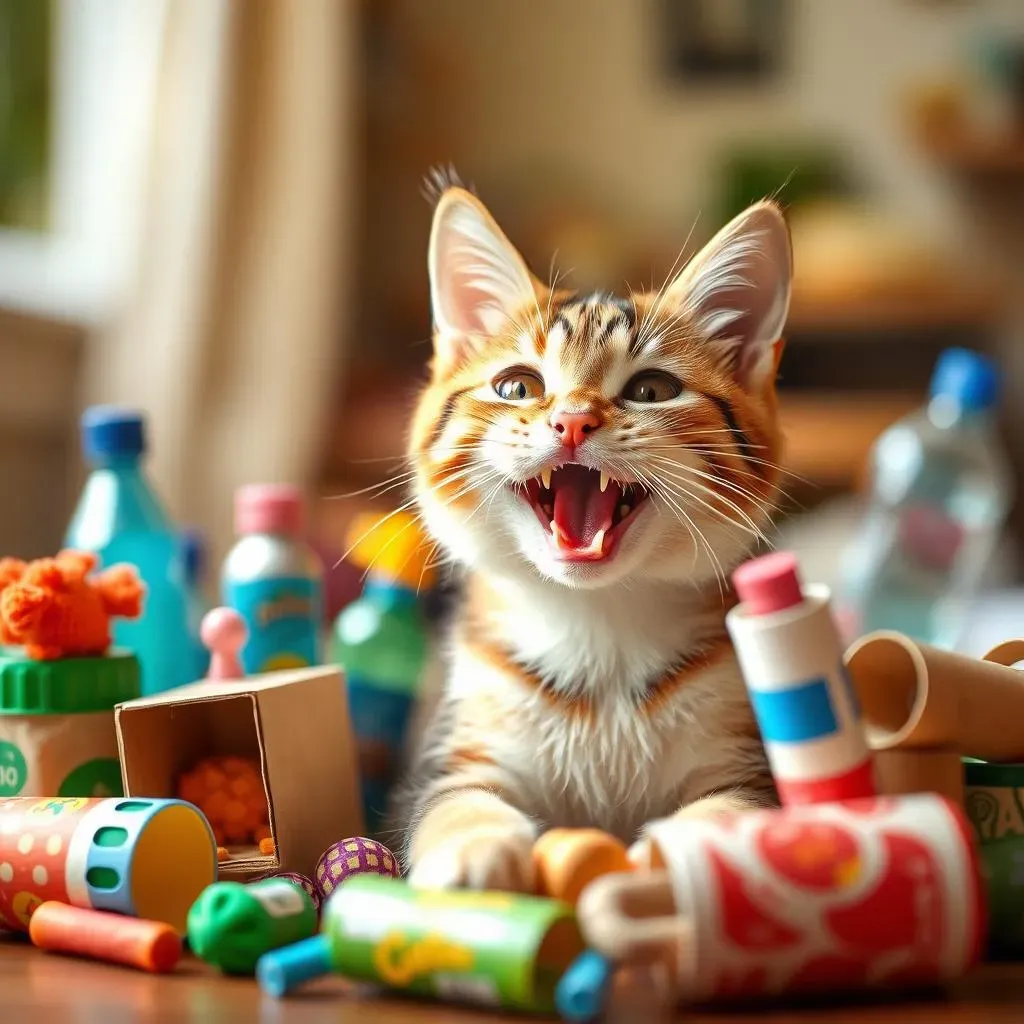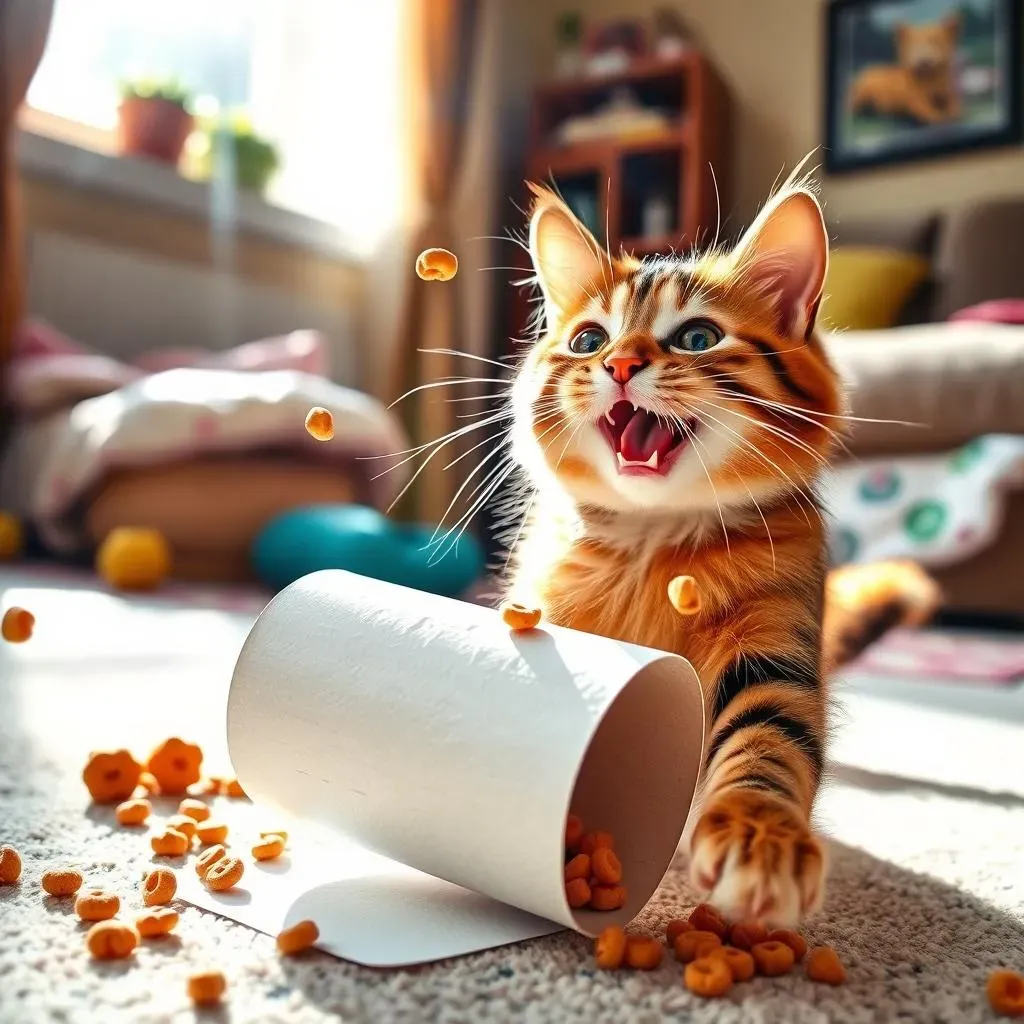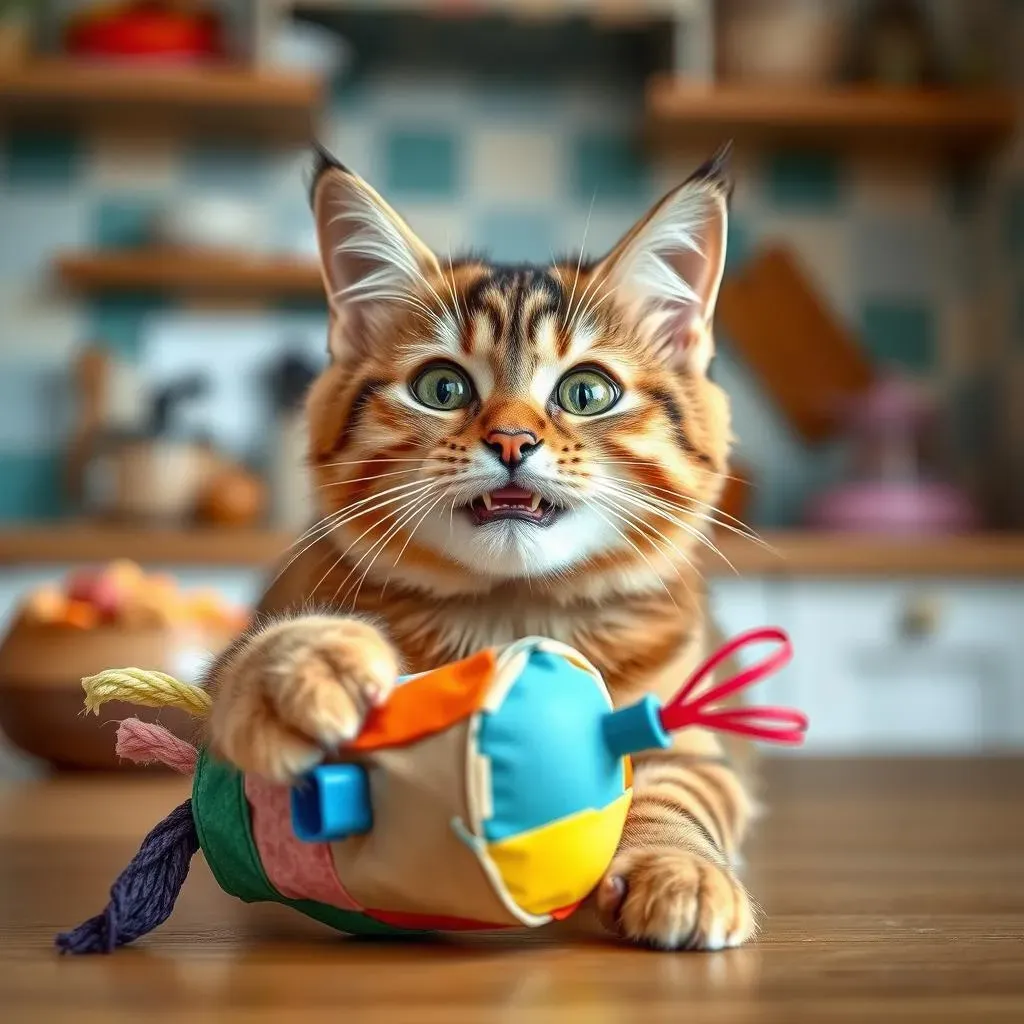Table of Contents
Ever watched your cat gobble down their food in seconds? It’s like they're training for an eating competition, not enjoying a meal. What if I told you there’s a way to turn mealtime into a fun, brain-boosting game? That’s where "cat food toy diy" projects come in. We're not talking about expensive store-bought puzzles; we're diving into the world of creating your own. This isn't just about slowing down their eating; it’s about tapping into their natural instincts to hunt and explore. Think of it as a treasure hunt, but with kibble! In this article, I'll show you how to make simple, safe, and engaging food puzzles using everyday household items. You’ll learn why these DIY toys are so great for your cat, get some easy project ideas, and pick up tips to make sure your cat's playtime is both fun and safe. Get ready to unleash your inner craft master and make mealtime an adventure for your feline friend!
Why DIY Cat Food Toys Rock

Why DIY Cat Food Toys Rock
The Boredom Buster
Let's face it, our feline friends can get bored easily. A bowl of food just doesn’t cut it for a creature that's hardwired to hunt. That’s where DIY cat food toys come in. They turn mealtime into a stimulating puzzle. It's like giving your cat a mental workout, which helps keep them engaged and less likely to turn your furniture into a scratching post. Plus, it's pretty fun watching them figure out how to get to their kibble, like a tiny, furry detective on a mission.
Think of it this way: would you rather eat a plain meal off a plate every day, or would you enjoy discovering your meal hidden in a fun spot? It's the same for our cats. These toys cater to their natural hunting instincts, providing a challenge that keeps them entertained and satisfied. And let's be honest, a happy cat means a happy home, right? It's a win-win for everyone.
Saving Money and the Planet
Another great thing about DIY cat food toys? They are super budget-friendly. Instead of spending a fortune on fancy store-bought puzzles, you can make your own with stuff you probably already have at home. We’re talking cardboard boxes, toilet paper rolls, and plastic bottles – things that would normally end up in the trash. This not only saves you money but also gives these items a second life. It’s like being a recycling superhero, but for your cat.
Plus, making these toys yourself lets you customize them to your cat's needs. Is your cat a super-smart puzzle solver? You can make things more challenging. Is your cat a bit of a newbie to puzzle games? Start with something simple. It’s all about tailoring the experience to make sure your cat is engaged and having a blast. And, let's be real, there’s a certain satisfaction in creating something that makes your cat happy, not to mention the planet a little bit happier, too.
Benefit | Why it Matters |
|---|---|
Mental Stimulation | Keeps cats engaged and reduces boredom. |
Cost-Effective | Saves money on expensive store-bought toys. |
Environmentally Friendly | Repurposes household items, reducing waste. |
Customizable | Can be adjusted to suit your cat's skill level. |
Easy DIY Cat Food Puzzle Ideas

Easy DIY Cat Food Puzzle Ideas
Okay, so you're ready to get crafty? Awesome! Let's talk about some super simple DIY cat food puzzle ideas that anyone can make. First off, the toilet paper roll is your best friend. Seriously, don't toss those cardboard tubes! You can fold in the ends to create a little pouch, then pop some kibble inside. Your cat will have to bat it around to get the food out. It's like a mini piñata for cats, but instead of candy, it's dinner. Another super easy idea is the muffin tin puzzle. Just drop some food into a few of the cups, cover the others with a toy or ball, and watch your cat figure out which ones hold the goodies. It's a low-effort, high-reward kind of project, perfect for those of us who aren't exactly Martha Stewart.
And if you're feeling a bit more ambitious, grab an empty egg carton. Just like the muffin tin, place food in some of the compartments, and let your cat sniff around to find the right spots. You can even cut out little holes in the top of the egg carton for extra challenge. The trick here is to make it engaging without being too frustrating. You want your cat to feel like they're winning, not like they're facing an impossible task. Remember, the goal is to keep them entertained and stimulated, so keep it simple and fun. These ideas are all about using what you've already got to create something awesome for your feline pal.
- Toilet Paper Roll Treat Dispenser: Fold the ends of a toilet paper roll, fill with kibble, and let your cat bat it around.
- Muffin Tin Puzzle: Place food in some muffin cups and cover others with toys.
- Egg Carton Forager: Put food in some egg carton compartments and let your cat explore.
- Cardboard Box Maze: Cut holes in a cardboard box and place food inside for a fun exploration.
Moving on, let’s talk about the magic of cardboard boxes. Seriously, cats and boxes are like peanut butter and jelly – they just go together. Grab a small box and cut a few holes in the top, just big enough for your cat to reach in with their paws. Then, sprinkle some kibble inside. It turns a simple box into an exciting foraging game. It’s all about making them use their natural instincts to seek out their food. And, if you're feeling extra creative, you can create a mini maze inside the box using cardboard dividers. The more twists and turns, the more fun your cat will have. It’s like creating a mini adventure park in your living room, but with dinner as the grand prize!
Don’t forget about the humble plastic bottle, either. Take a clean, empty plastic bottle, poke some holes in it, and fill it with kibble. Your cat will have to roll the bottle around to get the food to fall out. It's a simple idea, but it can keep them entertained for ages. Just make sure the holes are big enough for the kibble to come out easily but not so big that it all falls out at once. These simple DIY ideas prove you don't need fancy gadgets to keep your cat happy and engaged. It’s all about using your creativity and seeing everyday items in a new light. I swear, sometimes I think my cat is more entertained by a cardboard box than any store-bought toy, and that’s the beauty of "cat food toy diy".
Puzzle Idea | Materials | Difficulty |
|---|---|---|
Toilet Paper Roll | Toilet paper roll, kibble | Easy |
Muffin Tin | Muffin tin, kibble, toys | Easy |
Egg Carton | Egg carton, kibble | Easy |
Cardboard Box | Cardboard box, kibble | Medium |
Plastic Bottle | Plastic bottle, kibble | Medium |
Building a DIY Food Toy for Your Cat

Building a DIY Food Toy for Your Cat
Choosing the Right Materials
Okay, so you're pumped to build something cool for your cat, but where do you even start? First things first, let's talk materials. You need to pick things that are safe and sturdy. Cardboard is a great go-to because it's easy to work with and pretty cat-friendly. Toilet paper rolls, cereal boxes, and shipping cartons are all fair game. Just make sure there aren’t any staples or tape that could harm your cat. For plastic, think about old water bottles or yogurt containers, but always clean them out well. You want to avoid anything that could splinter or shatter, because safety is our number one priority here. Remember, we want a fun game, not a trip to the vet.
Also consider the size of your cat when choosing materials. A tiny kitten might have trouble with a giant box, while a bigger cat might need something more substantial. If you're using plastic, ensure the holes aren't too small, as a cat's claws could get stuck. And if you're using fabric, make sure it doesn't have any loose strings or ribbons that could be a choking hazard. It's all about making smart choices so your cat can play safely and happily. A little planning now can save a lot of headaches later. And let's be real, a happy cat means a happy you.
Material | Pros | Cons | Safety Tips |
|---|---|---|---|
Cardboard | Easy to work with, cat-friendly | Can get soggy with wet food | Remove staples, avoid tape |
Plastic (bottles, containers) | Durable, easy to clean | Can splinter or shatter | Clean thoroughly, avoid sharp edges |
Fabric | Soft, can be engaging | Can be a choking hazard | Remove loose strings, avoid small pieces |
Construction Tips and Tricks
Alright, so you’ve got your materials, now what? When you’re putting your toy together, keep it simple. You don't need to be an expert carpenter to build something fun. For cardboard boxes, use scissors or a box cutter to make holes, but be careful! Make sure the holes are big enough for your cat to reach in with their paws, but not so big that the food just falls out. If you’re making a treat dispenser from a plastic bottle, poke holes with a sharp tool, and make sure they are wide enough for the kibble to come out. It’s all about balance, not too easy, not too hard. Remember, the goal is to make it challenging, but not frustrating.
Also, think about how your cat plays. If your cat likes to bat things around, make sure the toy is sturdy enough to handle some action. If your cat prefers to sniff and explore, create a maze of holes and compartments. And don't be afraid to experiment! The best part about DIY is that you can adjust things as you go. If your cat isn’t interested in one design, try something new. It's all about finding what works best for your feline pal. And the most important rule? Always test the toy yourself to make sure it's safe before giving it to your cat. A little bit of testing can go a long way.
- Keep it Simple: Don't overcomplicate your design; simple is often more effective.
- Test it Out: Before giving it to your cat, test the toy yourself to ensure it's safe and fun.
- Adjust as Needed: If your cat isn't interested in one design, try something new and adjust as needed.
- Use Safe Tools: Always be careful when using scissors or box cutters, and supervise kids.
Safety and Fun with DIY Cat Food Toys

Safety and Fun with DIY Cat Food Toys
Keeping it Safe
Okay, so you’re all excited about your new DIY cat food toy, but let's pump the brakes for a second and talk safety. This is super important because we want our feline friends to have fun without getting hurt. First things first, always supervise your cat when they’re using a new toy, especially in the beginning. You need to make sure they're not trying to eat the cardboard or plastic, or getting their claws stuck in any small openings. If you see them chewing on something they shouldn’t, take the toy away immediately. It's like having a toddler; you need to be watching them to make sure they're not getting into trouble. And regularly check your toys for any damage, like broken pieces or loose parts, and replace them as needed. A little bit of vigilance goes a long way in keeping your kitty safe and sound.
Also, let's chat about materials again. You want to avoid anything that could be toxic or cause digestive issues. If you’re using plastic, be sure it's BPA-free and food-safe. Stay away from anything with small parts that could be swallowed. And if you're using cardboard, try to avoid anything with a lot of ink, because some inks could be harmful if ingested. Remember, we’re making these toys to enrich their lives, not put them in danger. It's all about being mindful and making smart choices. And hey, if you’re ever unsure about a material, it’s always better to err on the side of caution. A little extra care ensures your cat's playtime is both fun and safe.
Safety Tip | Why It's Important |
|---|---|
Supervise Playtime | Prevents cats from ingesting unsafe materials or getting stuck. |
Check for Damage | Ensures toys are in good condition and don't have loose parts. |
Use Safe Materials | Prevents cats from being exposed to toxic substances. |
Avoid Small Parts | Reduces the risk of choking hazards. |
Maximizing the Fun
Now that we've covered safety, let’s talk about making these toys as fun as possible! The key is to keep things interesting and challenging. Don't just give your cat the same puzzle every single day. Switch it up! Rotate your toys, add new challenges, and keep them guessing. It's like giving them a new adventure each time. And if your cat seems to master one puzzle, it’s time to make it more difficult. Maybe add more layers, more holes, or more compartments. The idea is to keep them engaged and stimulated, not bored. Remember, a happy and engaged cat is a cat that’s less likely to get into mischief.
Another cool tip is to involve your cat in the process. Let them watch you build the toy, or even let them sniff and explore the materials. This can build excitement and make them even more eager to play. And don’t forget to reward them with some praise and affection when they successfully solve the puzzle. Positive reinforcement goes a long way in making playtime a positive experience. Also, try to incorporate different textures and smells into your toys. A little catnip sprinkled inside can make things way more exciting. It’s all about creating an experience that appeals to all their senses. And let’s be honest, watching your cat have a blast is pretty rewarding for us humans, too.
- Rotate Toys: Keep things interesting by switching up the puzzles.
- Increase Difficulty: Adjust the challenges as your cat gets better at solving the puzzles.
- Involve Your Cat: Let them watch you build the toy to build excitement.
- Positive Reinforcement: Reward your cat with praise when they solve the puzzles.
Wrapping Up Your DIY Cat Food Toy Adventure
So, there you have it – a whole new world of fun for your cat, all made with your own two hands and a bit of creativity. "Cat food toy diy" projects aren't just about saving money; they're about enriching your cat's life, one puzzle at a time. Remember, the goal is to keep them engaged, stimulated, and most importantly, happy. Start simple, see what your cat enjoys, and don't be afraid to get a little experimental. With a little bit of effort, you can turn ordinary mealtime into an extraordinary adventure for your furry friend. Now go on, get crafting and watch your cat pounce on their new challenge!